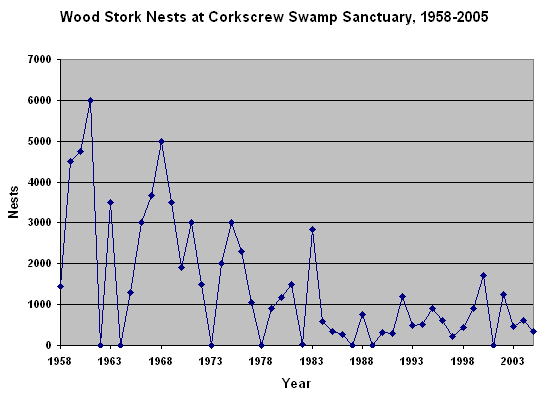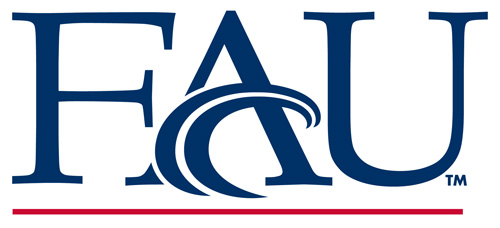
 Figure 2. The Southwest Florida Feasibility Study area
Figure 2. The Southwest Florida Feasibility Study area
The Issue
Declines in south Florida wading bird populations in the past several decades have sparked a great deal of research into the extent and causes of these declines. Ogden (1994) estimated that wading bird nesting populations in the southern Everglades had declined by more than 90% since the 1940s, and Kushlan and Frohring (1986) estimated that southern Florida wood stork populations had dropped by 75% from 1967 to 1982. Similar declines have been observed for wood storks in southwestern Florida (Fig. 1).
Figure 1. Wood stork nest numbers for Corkscrew Swamp, 1958-2005.
From data supplied by the National Audubon Society’s Corkscrew Swamp Sanctuary.In southwestern Florida, a system of canals and levees has changed many of the natural flow patterns and watershed boundaries that existed prior to human development. Wading bird population declines throughout south Florida have coincided with these altered hydrologic patterns (Browder 1978). In addition, unabated urban development in the region has resulted in large-scale habitat loss and fragmentation.
The declines in their populations following human alterations in hydropatterns suggest that wading birds might be suitable indicators for the southwestern Florida landscape. Wood storks, white ibises and snowy egrets appear to be more sensitive to hydropatterns than other wading birds (Gawlik 2002). Because of their narrow ecological tolerances and (especially in the case of the wood stork) wide foraging ranges, these birds are good indicator species. Also, they are conspicuous and relatively easy to survey (Frederick and Ogden 2003).
The availability of prey is believed to be a key factor influencing the population sizes and breeding success of wading birds in southern Florida (Kahl 1964). To breed successfully, wading birds require a large food supply throughout the breeding season. Wood storks eat mainly freshwater fish (Kahl 1964). Fish and crayfish make up the major part of the white ibis diet, which also includes aquatic insects and other small animals (Kushlan 1978, Kushlan 1979). Florida wetlands must be inundated with water for an appropriate period each year to produce prey populations that can sustain wading birds through the breeding season. Thus, good reproductive output by wading birds can be traced back to integrity of hydrologic patterns, a sign of overall ecosystem health.
Another constraint on wading bird reproductive success is that adequate prey must be present within a certain distance from the nest, or it will not be energetically advantageous for parental birds to complete the nesting cycle. Wood storks are able to take advantage of thermal currents to ascend high in the air, where they use highly efficient soaring-gliding flight to search for food far from the nest. Kahl (1964) observed storks feeding as far as 40 km from the nesting colony. White ibises, restricted to flapping flight, normally forage within 10 km of their nests (Bancroft et al. 1994).
In order to evaluate alternative restoration plans, a variety of models will be needed, including species-specific habitat suitability models. Ecological models have been developed for use in the Everglades restoration; however, there are differences in southwestern Florida that should be explicitly considered because they might affect the modeling approach. Southwestern Florida is comprised of many small to large wetlands with a variety of vegetation regimes. This greater complexity is the result of greater topographic variation, which leads to different hydrologic patterns than those present in the Everglades.
Browder (1978) developed a model for wood storks in southwestern Florida, specifically storks breeding at the Corkscrew Swamp Sanctuary. Her model is designed to relate stork breeding success to monthly rainfall. Although the model may adequately simulate actual processes, it may not detect events on a fine temporal scale, such as a significant rainfall event resulting in nest abandonment by breeding birds (Frederick and Collopy 1989). It also does not incorporate human influences such as those brought about by water management activities, which can affect water depths and recession rates over large areas separately from rainfall.
The model I propose to develop will incorporate all influences on hydropatterns, because water depths are measured on a weekly time step. This temporal scale is fine enough to detect changes in water depth that affect the foraging and breeding success of wood storks and white ibises.
- Identify factors of the southwestern Florida landscape that influence wading bird foraging habitat quality.
- Develop a computer-based model to simulate wading bird foraging habitat conditions and estimate reproductive success at the landscape level.
- Assess model performance.

